For many dog lovers, the joy of pet ownership is often overshadowed by persistent allergies. The sniffles, sneezes, and itchy eyes can make sharing a home with a furry friend a challenge. While many people turn to smaller, seemingly less allergenic breeds, a significant number of dog enthusiasts dream of welcoming a large companion into their lives without the constant battle against dander and shedding. The good news is, that dream is within reach!
Finding big dogs that don’t shed and are hypoallergenic can be a game-changer for individuals and families dealing with pet allergies. These magnificent breeds offer the loyalty, companionship, and impressive presence of a large dog, combined with a coat type that is far more accommodating to allergy sufferers. This guide will delve into what truly makes a dog “hypoallergenic,” highlight some of the best large non-shedding breeds, and provide essential tips for living harmoniously with your allergy-friendly giant.
What Exactly Makes a Dog “Hypoallergenic”?
It’s a common misconception that “hypoallergenic” means “100% allergen-free.” In reality, no dog is completely free of allergens. The term “hypoallergenic” simply means “less allergenic.” Most dog allergies are triggered not by the hair itself, but by proteins found in a dog’s dander (dead skin flakes), saliva, and urine. These allergens adhere to pet hair, which then sheds and disperses throughout the home, becoming airborne and settling on surfaces.
Dogs classified as hypoallergenic typically have coats that shed very minimally, if at all. This means they release less dander into the environment. Their hair often grows continuously, similar to human hair, rather than having a growth cycle that results in heavy shedding. While these breeds produce the same allergenic proteins as any other dog, the reduced shedding significantly lessens the amount of allergens circulating in your home, making them a much better fit for individuals with sensitivities. It’s crucial to remember that individual reactions can vary, and spending time with a specific breed before adoption is always recommended. For those specifically seeking low-allergen companions, understanding these intelligent dog breeds that don t shed can be a great starting point for further research.
Why Choose a Big Dog That Doesn’t Shed?
The appeal of big dogs is undeniable. Their commanding presence, often gentle giants, and capacity for active lifestyles make them desirable companions. When you combine these traits with a low-shedding, hypoallergenic coat, you get the best of both worlds:
- Reduced Allergens: The primary benefit, of course, is a home with fewer airborne allergens, leading to fewer allergy symptoms for sensitive individuals.
- Less Housekeeping: Less shedding means less dog hair on your furniture, floors, and clothes, simplifying your cleaning routine.
- Active Companionship: Many large breeds thrive on activity and outdoor adventures. A non-shedding big dog allows active individuals and families to enjoy hiking, running, and playing without worrying about excessive hair cleanup.
- Stronger Presence: Big dogs often provide a greater sense of security and make excellent cuddle buddies, offering comfort and companionship without irritating allergies.
Top Big Hypoallergenic Dogs That Don’t Shed
While many hypoallergenic breeds are small, there’s a fantastic selection of larger dogs that fit the bill. Here are some of the best big dogs that don’t shed and are hypoallergenic, offering both size and allergy-friendliness.
1. Standard Poodle
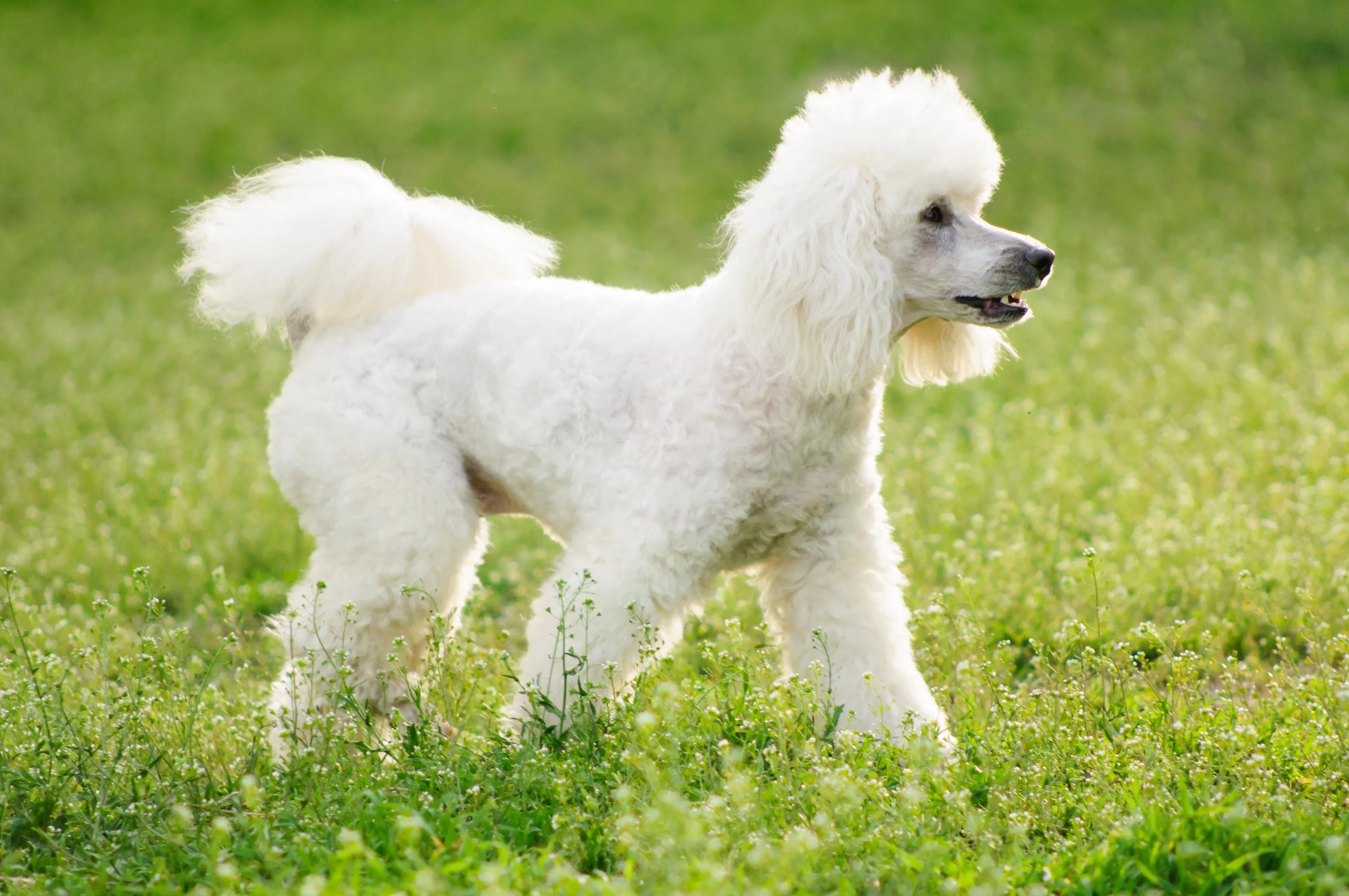 White Standard Poodle happily running through a lush green field
White Standard Poodle happily running through a lush green field
The Poodle comes in three sizes (Toy, Miniature, and Standard), but the Standard Poodle is a prime example of a big dog that doesn’t shed. Originally bred as water retrievers, these dogs are highly intelligent, agile, and eager to please. Standard Poodles can weigh between 45 to 70 pounds and stand over 15 inches tall, making them substantial companions. Their dense, curly coat traps loose dander and hair, preventing it from spreading throughout your home. This continuous-growth coat requires regular grooming, including brushing several times a week and professional clipping every 4-6 weeks, to prevent matting and keep them looking their best. Beyond their hypoallergenic qualities, Standard Poodles are known for their playful nature, trainability, and devotion to their families, adapting well to various living situations as long as they receive adequate physical and mental stimulation.
2. Standard Schnauzer
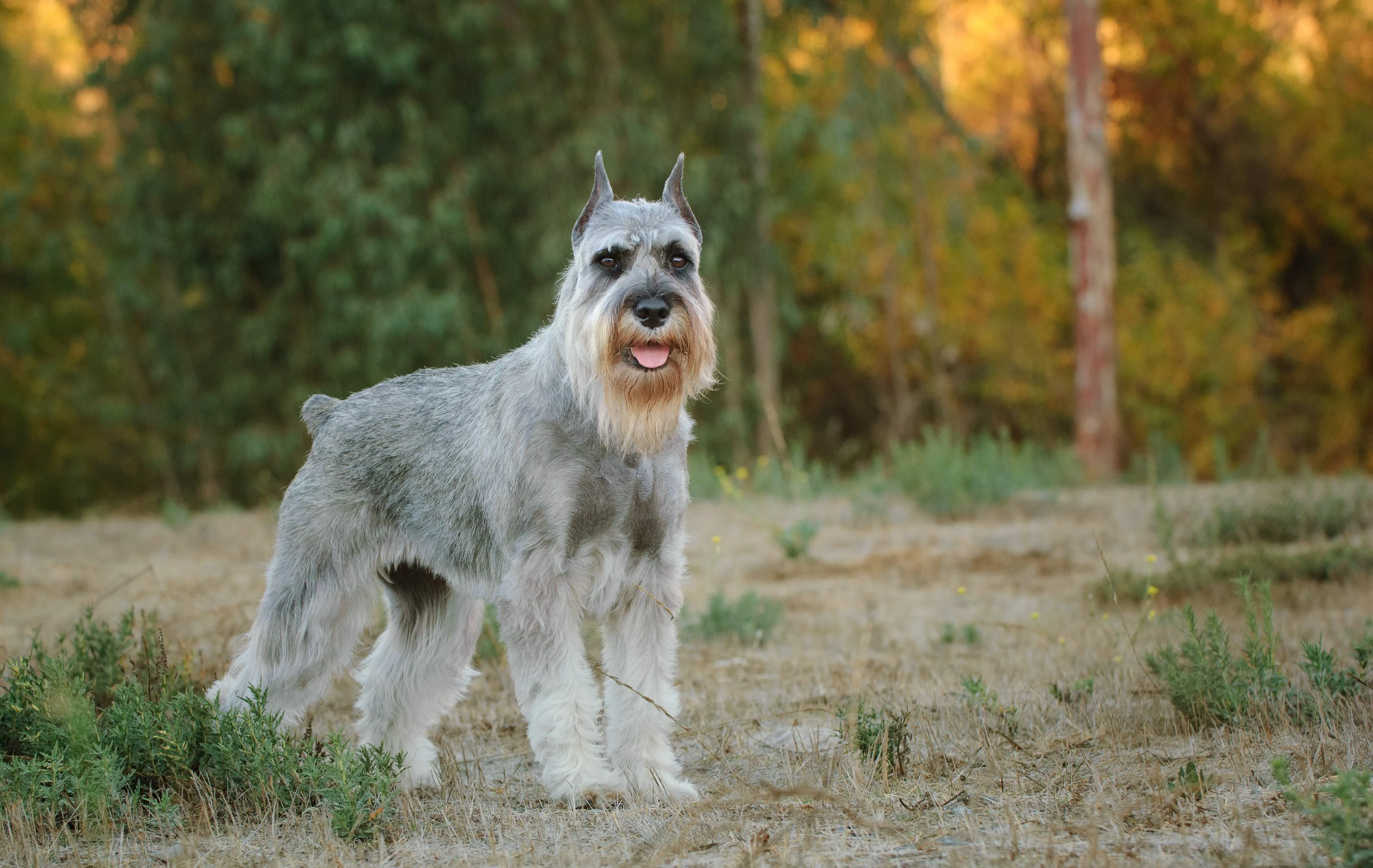 Alert gray Standard Schnauzer standing attentively in a grassy field
Alert gray Standard Schnauzer standing attentively in a grassy field
The Standard Schnauzer is a robust, medium-large breed known for its distinctive bushy eyebrows and beard. Weighing up to 45 pounds and standing around 17.5 to 19.5 inches tall, they offer a sturdy build without excessive shedding. Their wiry, dense double coat, much like the Poodle’s, traps dander and shed hair, making them a good choice for allergy sufferers. Regular hand-stripping or professional grooming every few months is essential to maintain the coat’s texture and minimize shedding. Standard Schnauzers are intelligent, spirited, and protective, requiring consistent training and plenty of exercise to channel their energy. They make excellent family guardians and active companions, thriving on engagement and purposeful activities.
3. Giant Schnauzer
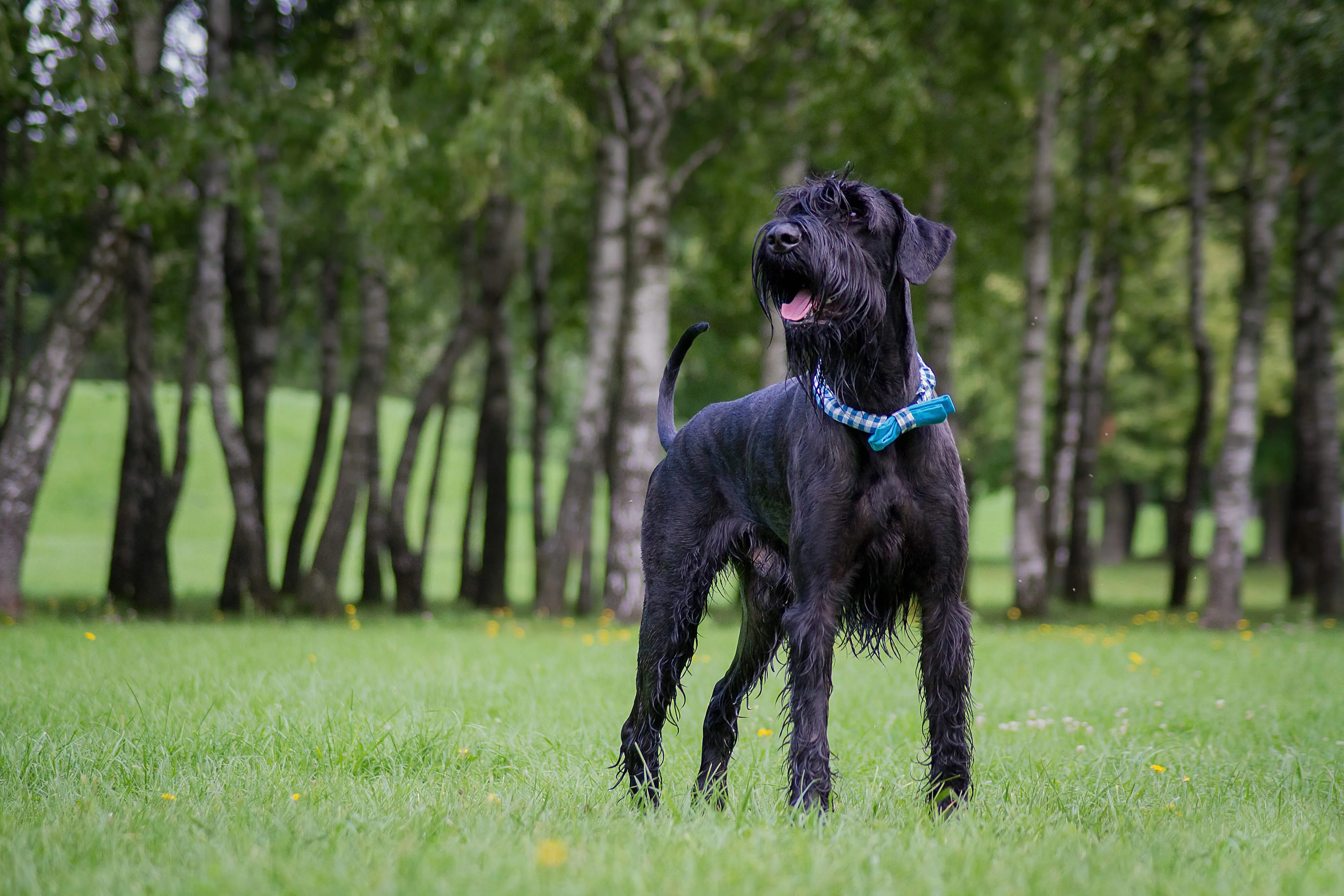 Majestic black Giant Schnauzer with a blue collar standing confidently in a park
Majestic black Giant Schnauzer with a blue collar standing confidently in a park
For those seeking truly big dogs that don’t shed and are hypoallergenic, the Giant Schnauzer is an impressive choice. As the largest of the Schnauzer family, these dogs can weigh between 65 to 85 pounds and stand up to 27.5 inches tall. Like their smaller relatives, they possess a coarse, wiry outer coat and a soft undercoat, which contribute to their low-shedding profile. However, this coat requires dedicated grooming, including weekly brushing and regular hand-stripping or clipping every 6-8 weeks, to prevent mats and ensure skin health. Giant Schnauzers are highly intelligent, loyal, and powerful dogs that excel in various canine sports and protection work. They need an experienced owner who can provide firm, consistent training and abundant exercise to manage their high energy levels and strong will. Their imposing size and hypoallergenic coat make them one of the biggest dog breed that doesn t shed options available.
4. Portuguese Water Dog
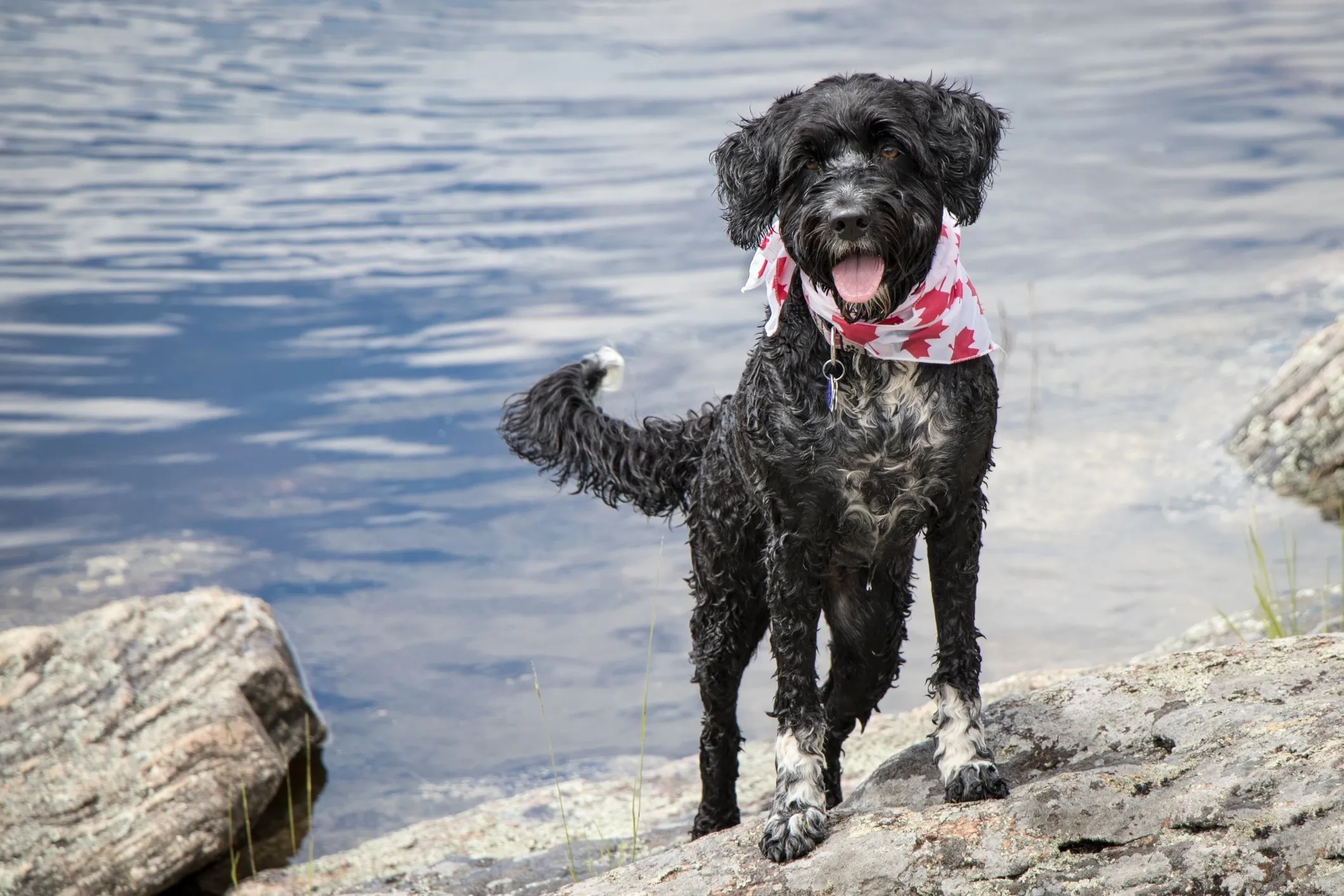 Black and white Portuguese Water Dog wearing a red bandana, alert by a body of water
Black and white Portuguese Water Dog wearing a red bandana, alert by a body of water
The Portuguese Water Dog is a robust, intelligent, and highly active breed perfectly suited for families looking for a medium-large hypoallergenic companion. Males can weigh up to 60 pounds and females up to 50 pounds, with heights ranging from 17 to 23 inches. Their waterproof, non-shedding coat can be either wavy or curly, designed to protect them from the cold Atlantic waters they once worked in alongside fishermen. This coat requires regular brushing (at least 2-3 times a week) and professional grooming every 6-8 weeks to keep it healthy and prevent matting. Portuguese Water Dogs are known for their energetic, adventurous, and affectionate nature. They are highly trainable and thrive on activities that engage both their bodies and minds, especially water-related sports. Their zest for life and allergy-friendly coats make them a fantastic choice for active households.
5. Standard Labradoodle
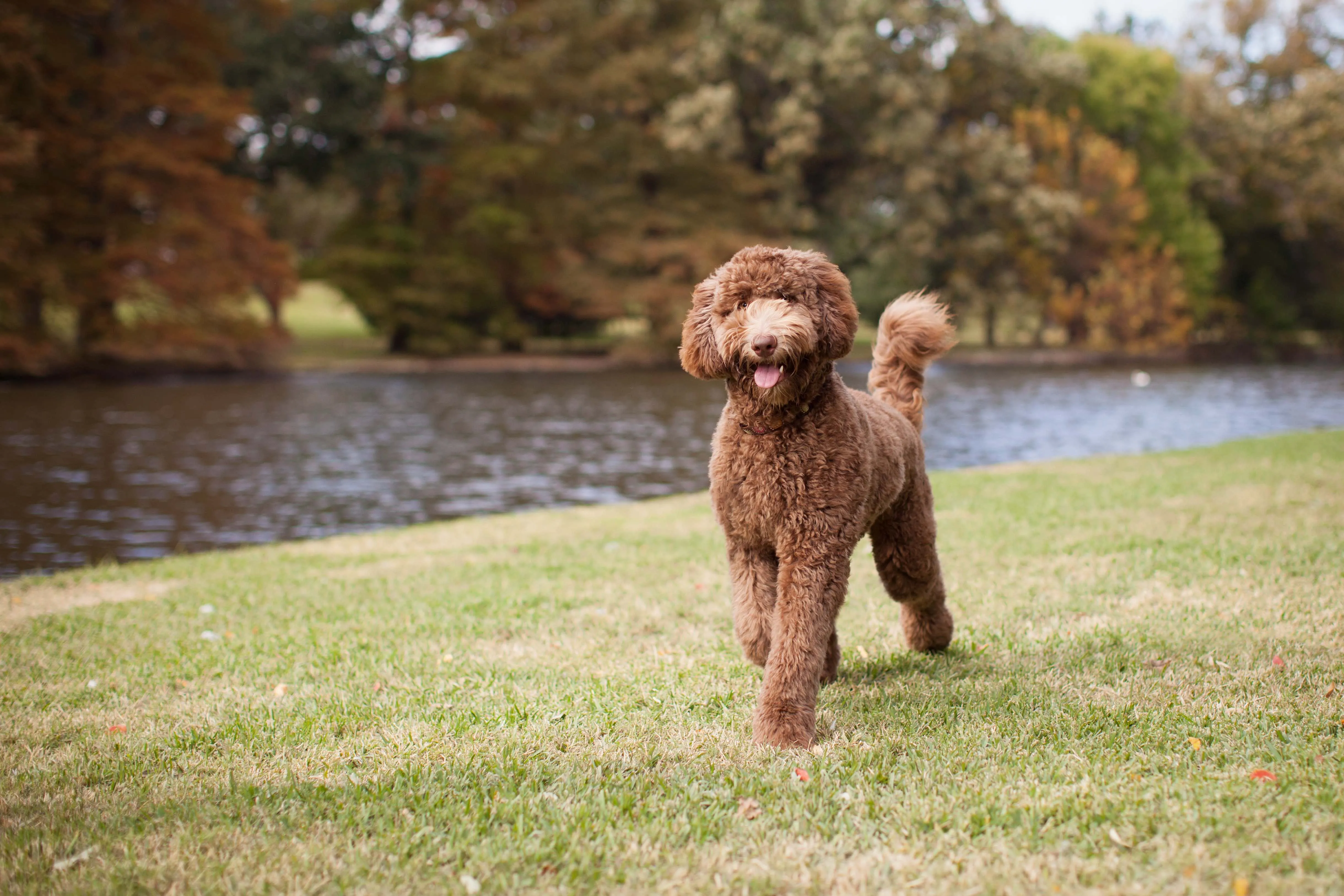 Friendly brown Standard Labradoodle walking happily through an autumn park
Friendly brown Standard Labradoodle walking happily through an autumn park
A cross between the Labrador Retriever and the Poodle, the Standard Labradoodle combines the beloved temperament of the Lab with the low-shedding coat of the Poodle. While coat types can vary, many Labradoodles inherit the Poodle’s curly or wavy coat, making them excellent candidates for allergy sufferers. Standard Labradoodles are considered big dogs, typically weighing between 50 to 75 pounds and standing 21 to 24 inches tall. Their coats generally require brushing 2-3 times a week and professional grooming every 6-12 weeks, depending on the coat type. Known for their friendly, intelligent, and eager-to-please personalities, Labradoodles are often described as having the best traits of both parent breeds. They are highly adaptable, making wonderful family pets, service dogs, and therapy dogs, provided they receive sufficient exercise and mental stimulation.
6. Standard Goldendoodle
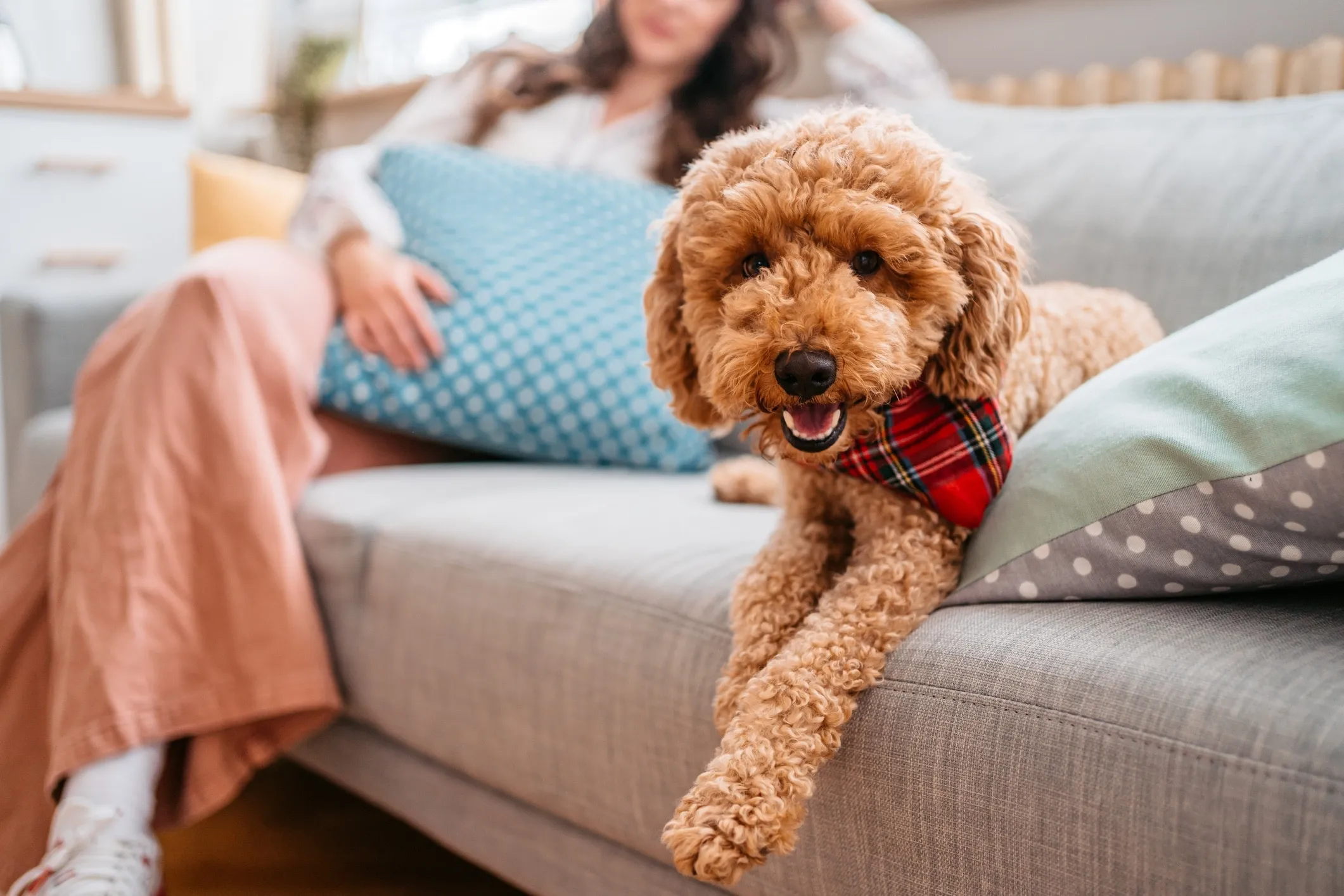 Fluffy golden Goldendoodle lying comfortably on a couch with a person in the background
Fluffy golden Goldendoodle lying comfortably on a couch with a person in the background
Similar to the Labradoodle, the Standard Goldendoodle is a cross between a Golden Retriever and a Poodle, celebrated for its charming personality and typically low-shedding coat. These can be quite large dogs, with standard sizes ranging from 50 to 90 pounds and 20 to 24 inches in height. Their wavy or curly coats are a major draw for allergy sufferers, though consistent grooming is necessary. Weekly brushing is recommended, along with professional grooming every 6-8 weeks to prevent mats and tangles. Goldendoodles are known for their gentle, affectionate, and intelligent nature, making them exceptional family pets and therapy dogs. They are highly trainable and sociable, thriving on companionship and active play. Their popularity among most popular dog breeds that don t shed is well-deserved.
7. Irish Water Spaniel
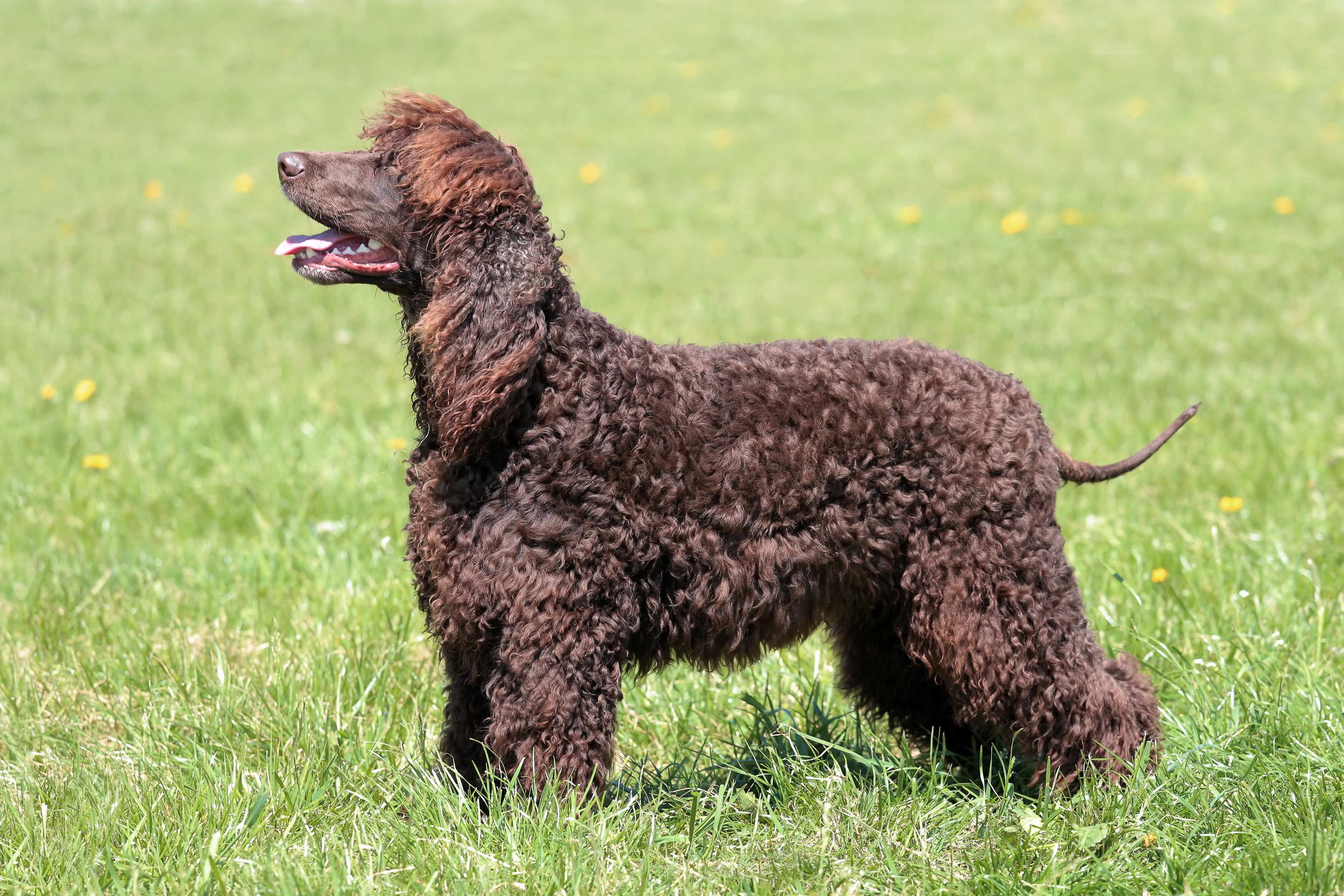 Distinguished brown Irish Water Spaniel in profile, looking alert outdoors
Distinguished brown Irish Water Spaniel in profile, looking alert outdoors
A truly unique and striking breed, the Irish Water Spaniel is a robust sporting dog with a distinct curly, water-repellent coat. These are medium to large dogs, with males weighing 55-68 pounds and standing 22-24 inches tall. Their liver-colored, tight curls don’t shed much, making them a suitable option for those with allergies. Regular brushing (2-3 times a week) and occasional trimming are needed to maintain their coat and prevent matting. Irish Water Spaniels are known for being intelligent, playful, and somewhat clownish, with a strong desire to please their owners. They possess a high energy level and require plenty of exercise, including swimming, to stay happy and healthy. Their intelligent minds also benefit from training and mentally stimulating activities.
8. Standard Aussiedoodle
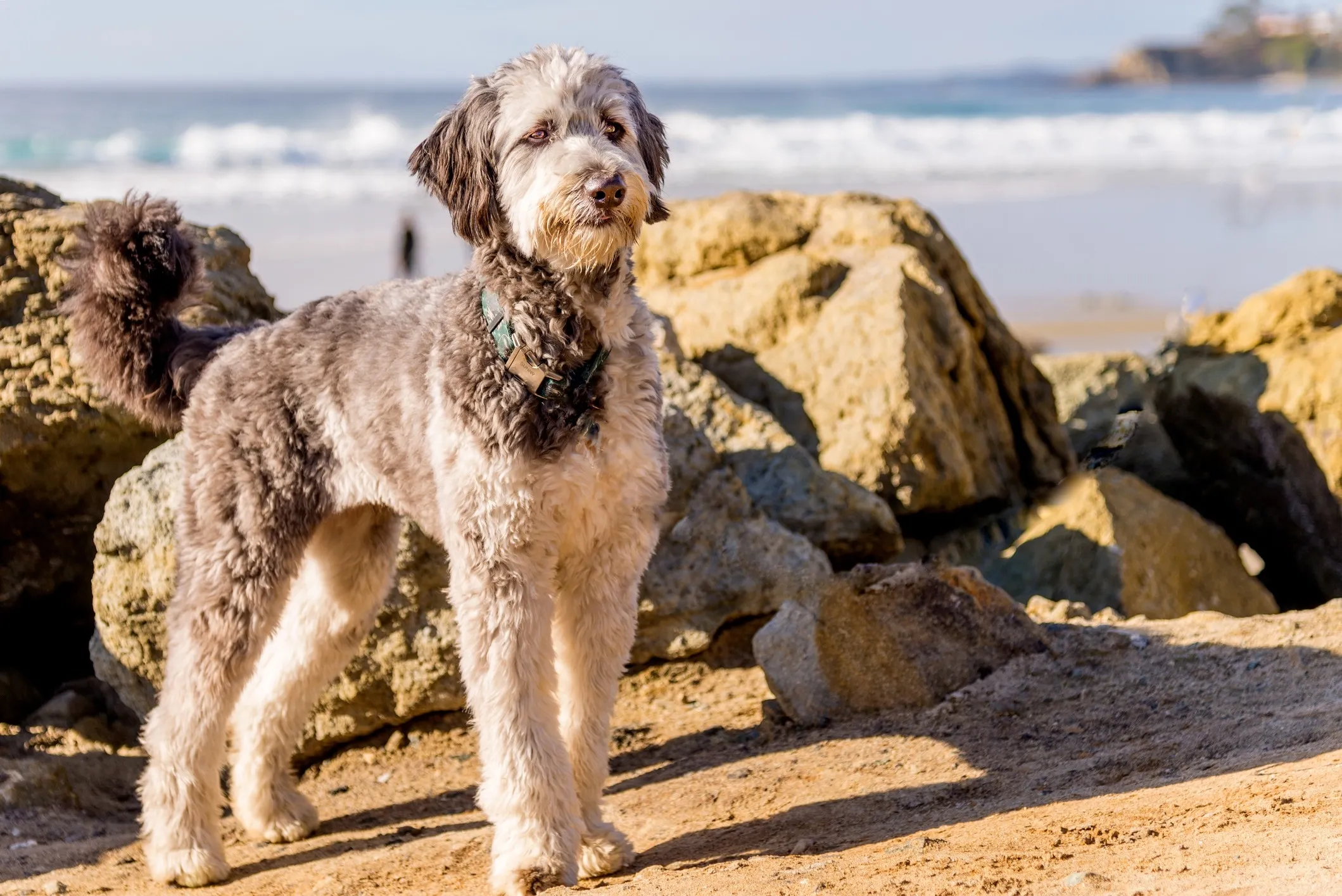 Energetic standard Aussiedoodle dog standing on a sandy beach, gazing out
Energetic standard Aussiedoodle dog standing on a sandy beach, gazing out
The Standard Aussiedoodle is a dynamic crossbreed resulting from the pairing of an Australian Shepherd and a Standard Poodle. Combining the intelligence and energy of both parents, these dogs can be quite substantial, typically weighing 40-70 pounds and standing 18-25 inches tall. Their coats can vary from wavy to curly, and while not all are guaranteed to be non-shedding, many inherit the Poodle’s low-shedding qualities, making them allergy-friendly. Regular brushing (several times a week) and professional grooming every 6-12 weeks are important for coat maintenance. Aussiedoodles are highly intelligent, playful, and affectionate dogs that excel in active homes. They require significant mental and physical exercise to prevent boredom and potential destructive behaviors, making them ideal for owners committed to training and engaging their dogs.
9. Soft Coated Wheaten Terrier
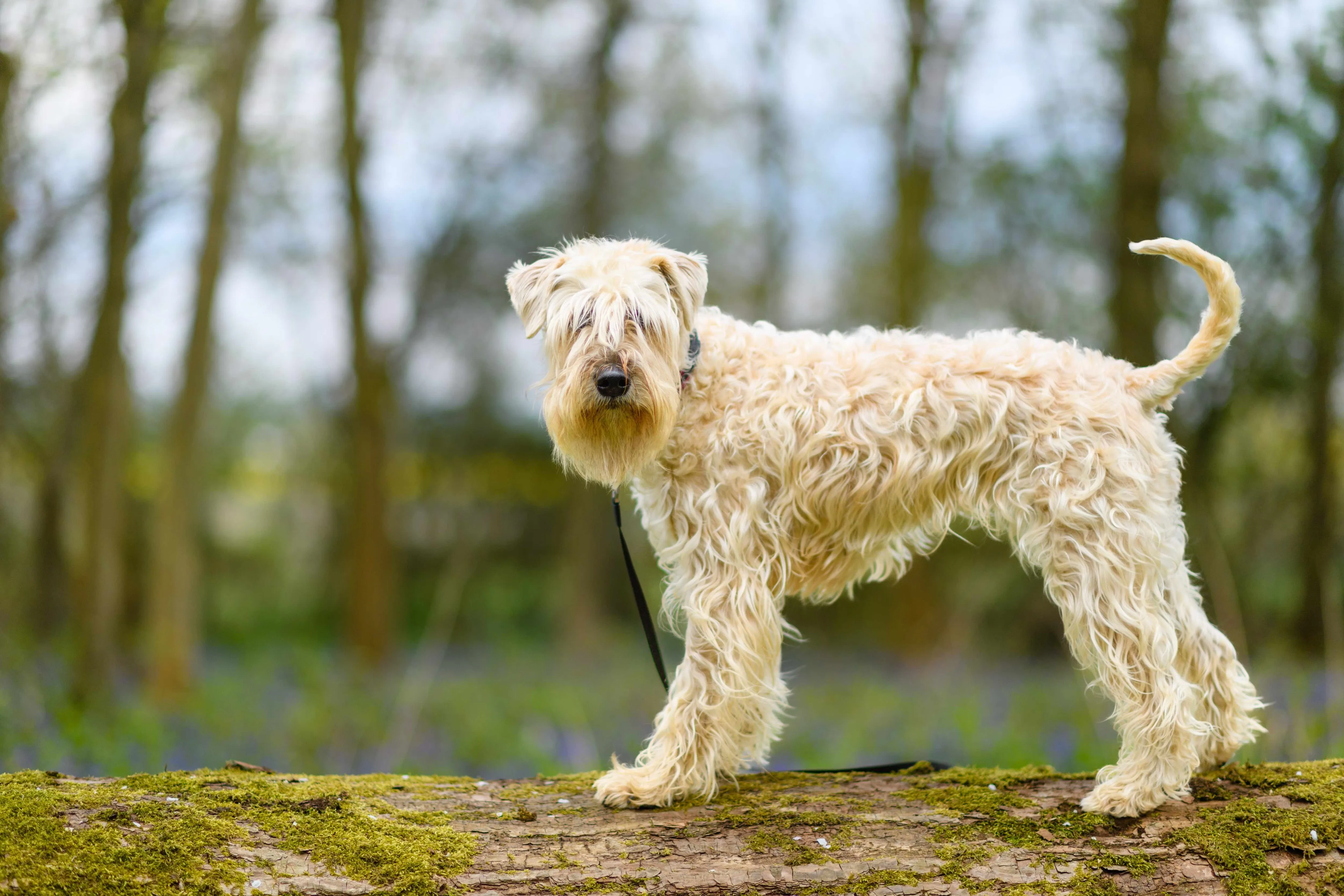 Joyful Soft Coated Wheaten Terrier resting on a rustic log outdoors
Joyful Soft Coated Wheaten Terrier resting on a rustic log outdoors
The Soft Coated Wheaten Terrier is a lively, medium-sized Irish breed known for its silky, soft, wheat-colored coat that sets it apart from other terriers. While often considered a medium dog (30-40 pounds, 17-19 inches tall), their robust build and boundless energy give them a larger presence. Their single coat sheds minimally, making them a good choice for allergy sufferers. However, their soft coat requires daily brushing to prevent mats and tangles, and occasional trimming to keep it neat. Wheatens are cheerful, affectionate, and energetic, often described as having a “wheaten greeting” where they jump up to welcome people. They need consistent training and ample exercise to manage their typical terrier exuberance and ensure they are well-behaved family members.
10. Standard Schnoodle
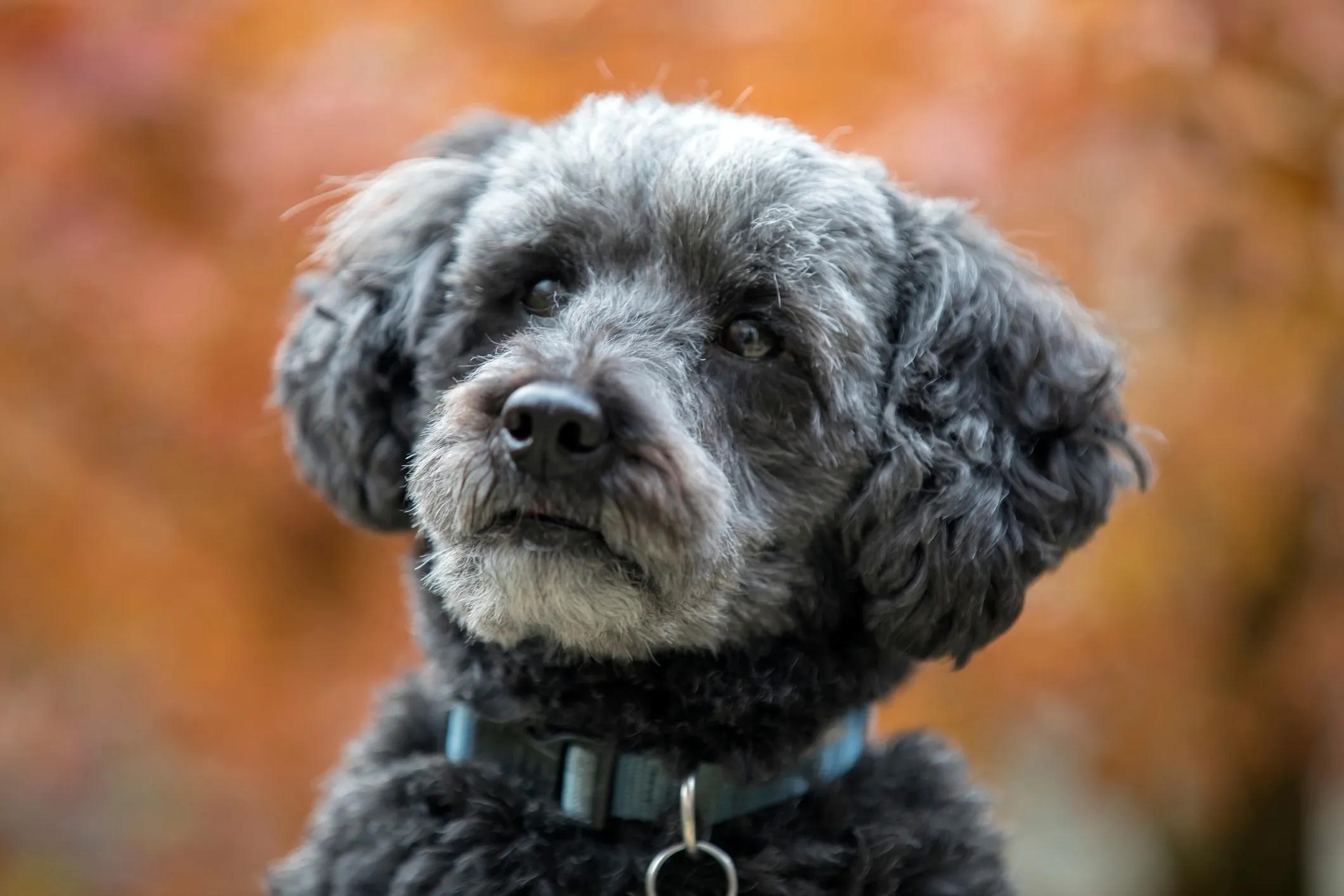 Close-up of a Schnoodle dog with a gray, wavy coat, looking inquisitively
Close-up of a Schnoodle dog with a gray, wavy coat, looking inquisitively
A Schnoodle is a delightful cross between a Schnauzer and a Poodle, bringing together two already hypoallergenic breeds. The “Standard” Schnoodle, resulting from Standard Poodle and Standard Schnauzer parents, can be a sizable companion, often weighing 40-75 pounds and standing 15-26 inches tall. Their coats can range from wavy to curly, all with the desirable low-shedding quality. Regular brushing and professional grooming every 6-8 weeks are crucial for maintaining their coat’s health and appearance. Schnoodles are known for their intelligent, playful, and affectionate temperaments. They are generally good-natured, adaptable dogs that thrive on companionship and enjoy being involved in family activities. Their intelligence makes them highly trainable, responding well to positive reinforcement.
11. Standard Xoloitzcuintli
 Majestic black hairless Xoloitzcuintli standing tall in verdant grass
Majestic black hairless Xoloitzcuintli standing tall in verdant grass
The Xoloitzcuintli, or Mexican Hairless Dog, is an ancient and rare breed known for its striking appearance and hypoallergenic qualities. It comes in three sizes: Toy, Miniature, and Standard. The Standard Xoloitzcuintli is a big dog, weighing 30-55 pounds and standing 18-23 inches tall. The hairless variety is naturally hypoallergenic due to the absence of a coat, meaning no dander-laden hair to shed. A coated variety also exists, with a very short, smooth coat that sheds minimally. While hairless, they still require skin care, including moisturizing and sun protection. Xolos are intelligent, calm, and loyal companions, often forming deep bonds with their families. They can be reserved with strangers but are affectionate with their loved ones, requiring early socialization and consistent training.
12. Standard Whoodle
 Charming tan Whoodle puppy curiously dragging a washcloth on a wooden floor
Charming tan Whoodle puppy curiously dragging a washcloth on a wooden floor
The Whoodle is a crossbreed between a Soft Coated Wheaten Terrier and a Poodle. Combining the best qualities of both parent breeds, the Whoodle is known for its friendly demeanor and low-shedding coat. When bred with a Standard Poodle, the resulting Whoodle can be a medium to large dog, often weighing 40-60 pounds and standing 18-20 inches tall. Their wavy or curly coat is soft and requires regular brushing (a few times a week) and occasional professional grooming to prevent matting. Whoodles are intelligent, playful, and affectionate dogs that thrive on human companionship. They have a moderate to high energy level, making them excellent companions for active families who can provide them with sufficient exercise and mental stimulation.
13. Bernedoodle
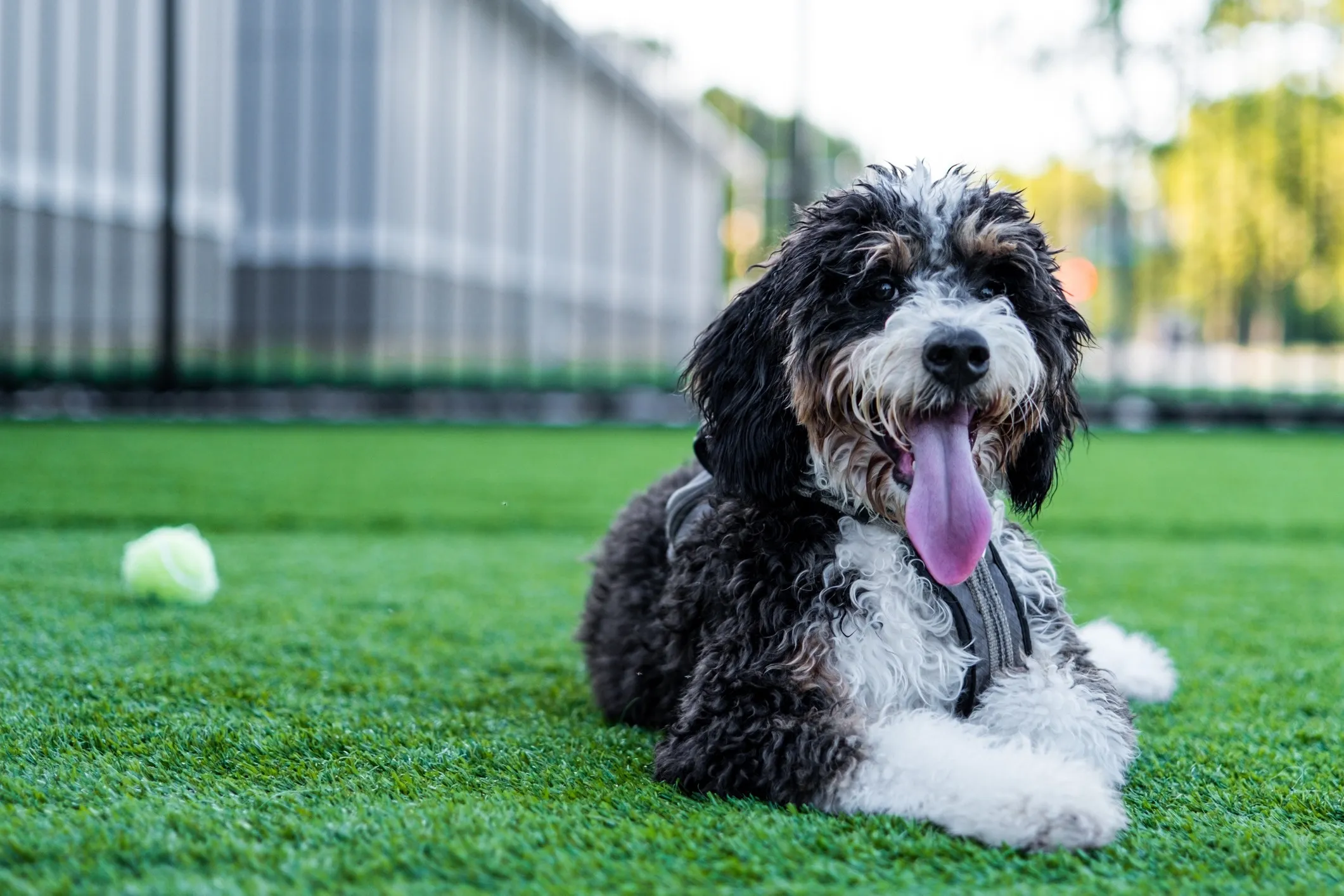 Happy Bernedoodle dog with tri-color fur lying in green grass with its tongue out
Happy Bernedoodle dog with tri-color fur lying in green grass with its tongue out
The Bernedoodle is a cross between the majestic Bernese Mountain Dog and the intelligent Poodle. This hybrid is one of the larger hypoallergenic options, with Standard Bernedoodles typically weighing 70-90 pounds (or even more) and standing 23-29 inches tall. Their coat varies, but many inherit the Poodle’s low-shedding characteristics, ranging from wavy to curly, making them suitable for allergy sufferers. Regular brushing (several times a week) and professional grooming every 8-12 weeks are essential to manage their thick coats. Bernedoodles are renowned for their gentle, friendly, and goofy personalities. They are excellent family dogs, known for their patience with children and other pets, and their strong desire to be involved in family life. They require moderate to high exercise and consistent training due to their size and intelligence.
14. Afghan Hound
 Elegant gray and tan Afghan Hound with flowing hair, looking directly at the camera
Elegant gray and tan Afghan Hound with flowing hair, looking directly at the camera
With its aristocratic appearance and long, flowing coat, the Afghan Hound is an unmistakable breed. While their magnificent hair may suggest otherwise, Afghan Hounds are considered low-shedding and can be suitable for some allergy sufferers. These are large, lean dogs, typically weighing 50-60 pounds and standing 25-27 inches tall. Their silky, luxurious coat requires significant grooming, including daily brushing to prevent mats and tangles, and regular bathing to keep it clean and healthy. Afghan Hounds are known for their independent, dignified, and somewhat aloof nature. While affectionate with their families, they can be reserved with strangers. They are built for speed and endurance, requiring plenty of opportunities for running and exercise in a securely fenced area.
15. Barbet
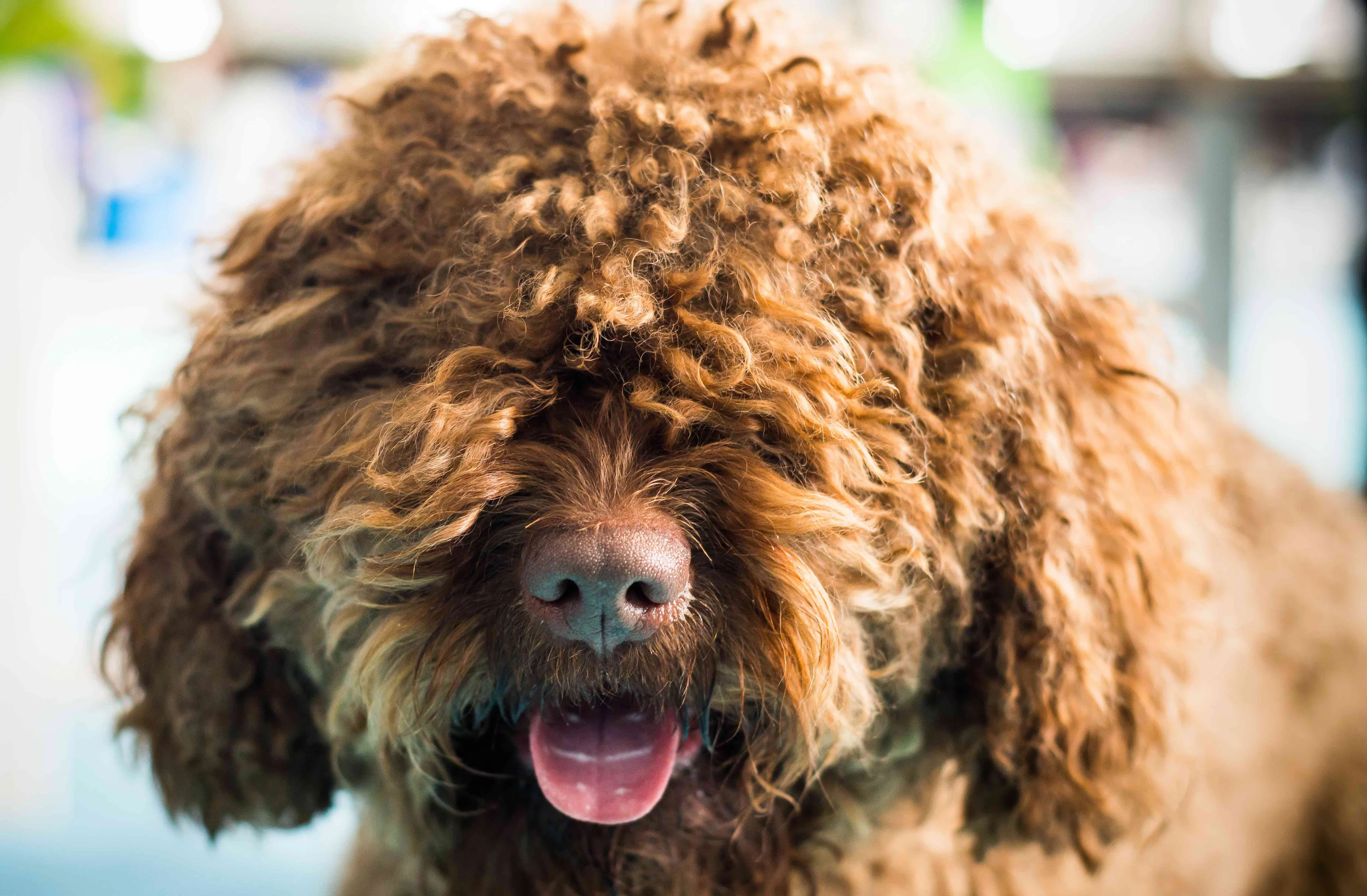 Close-up of a Barbet dog's curly reddish-brown face, looking friendly and attentive
Close-up of a Barbet dog's curly reddish-brown face, looking friendly and attentive
The Barbet, pronounced “bar-bay,” is a cheerful and water-loving French breed known for its shaggy, woolly, and curly coat. These are medium to large dogs, weighing 35-65 pounds and standing 19-25 inches tall. Their dense, non-shedding coat is excellent for trapping dander and preventing it from spreading, making them a great hypoallergenic option. However, this coat requires dedicated grooming, including thorough brushing 2-3 times a week and professional clipping every few months, especially if they spend time swimming. Barbets are intelligent, friendly, and sociable dogs that thrive on companionship. They are highly trainable and enjoy activities that involve water. Their joyful disposition and moderate energy levels make them wonderful family pets for active households.
16. Standard Peruvian Inca Orchid
 Distinctive Peruvian Inca Orchid dog with minimal hair, standing gracefully
Distinctive Peruvian Inca Orchid dog with minimal hair, standing gracefully
The Peruvian Inca Orchid is another ancient hairless breed that offers a hypoallergenic option in larger sizes. This breed comes in small, medium, and large varieties, with the Standard Peruvian Inca Orchid weighing 26-55 pounds and standing 19.5-25.5 inches tall. Like the Xoloitzcuintli, their hairless characteristic means they shed virtually no dander, making them highly allergy-friendly. There is also a coated variety with a very short, minimal coat. The hairless variety requires skin protection from sun and cold, as well as regular moisturizing. Peruvian Inca Orchids are noble, alert, and affectionate dogs with their families, though they can be wary of strangers. They are intelligent and agile, requiring regular exercise and mental stimulation.
Living Successfully with a Big Hypoallergenic Dog
Bringing home any dog, especially a large breed, requires preparation and commitment. For big hypoallergenic dogs, a few specific considerations can ensure a happy, healthy, and sneeze-free home.
Consistent Grooming is Key
Even though these dogs are low-shedding, their unique coats demand regular maintenance.
- Brushing: Most require brushing several times a week to prevent mats and tangles. Breeds like the Poodle, Labradoodle, and Goldendoodle, with their continuously growing coats, can mat quickly if neglected.
- Bathing: Regular bathing (every 4-6 weeks or as needed) helps remove any accumulated dander and keep the coat clean. Use a gentle, dog-specific shampoo.
- Professional Grooming: Many of these breeds will need professional clipping or hand-stripping every 4-12 weeks to maintain their coat’s health and manage length. Factor this into your budget and time commitment. For example, dogs like the Standard Poodle and Giant Schnauzer benefit greatly from professional care to keep their coats in top condition.
Maintaining an Allergen-Friendly Home
Beyond grooming your dog, managing your home environment is crucial for minimizing allergens.
- Regular Cleaning: Vacuum frequently with a HEPA-filter vacuum, dust surfaces, and wash bedding (yours and your dog’s) regularly.
- Air Purifiers: Consider using high-efficiency particulate air (HEPA) purifiers in common areas to capture airborne allergens.
- Designated Dog Zones: While companionship is wonderful, consider having areas where your dog isn’t allowed, such as bedrooms, to create allergen-free zones.
- Limit Carpet: Hardwood, tile, or laminate flooring can be easier to clean and harbor fewer allergens than carpets.
Consulting Your Healthcare Provider
If you or a family member has severe allergies, it’s always best to consult with your healthcare provider or an allergist. They can provide personalized advice, discuss potential treatments (such as medication or immunotherapy), and help you manage your allergies effectively alongside your pet. Understanding your specific triggers can help you implement the most effective strategies for a comfortable coexistence.
Exercise and Training Needs of Larger Breeds
Remember that “big” dogs come with “big” needs for exercise and training.
- Ample Exercise: Most large breeds, especially those with working dog backgrounds like the Portuguese Water Dog or Standard Poodle, require significant daily exercise to stay physically and mentally healthy. This can include long walks, runs, hikes, or vigorous play sessions.
- Consistent Training: Their size and strength mean that good manners and obedience training are paramount. Early socialization and consistent positive reinforcement training are essential to ensure your big hypoallergenic dog grows into a well-behaved and manageable companion. Without adequate exercise and training, these intelligent and energetic dogs can develop behavioral issues due to boredom or pent-up energy.
Conclusion
Embracing a big dog doesn’t mean you have to sacrifice a life free from allergy symptoms. By carefully selecting from the wonderful world of big dogs that don’t shed and are hypoallergenic, you can enjoy the immense love, loyalty, and companionship that a large canine friend brings, all while keeping allergens at bay. Breeds like the majestic Bernedoodle, the intelligent Standard Poodle, and the unique Giant Schnauzer offer the best of both worlds.
Remember that commitment to regular grooming, maintaining a clean home, and understanding the specific needs of your chosen breed are essential for a successful and joyful life together. With the right preparation and knowledge, your allergy-friendly giant will not only be a beloved pet but also a cherished member of your family, enhancing your life in countless ways without triggering those pesky allergies. Explore these incredible breeds and find the perfect big, non-shedding companion for your home!
References:
- PetMD. “Hypoallergenic Dogs: The 30 Best Dog Breeds for Allergies.” PetMD.com. Accessed [Current Date]. (Original article used as primary source for breed information and general allergy facts).
